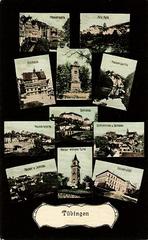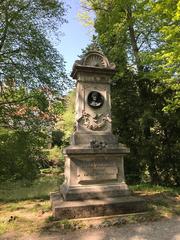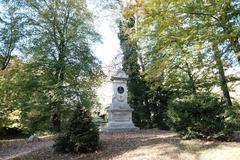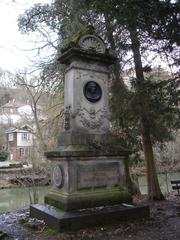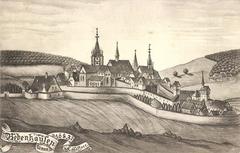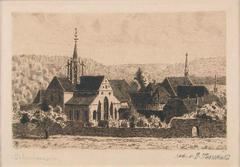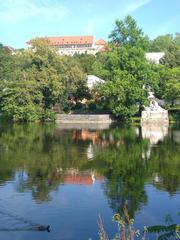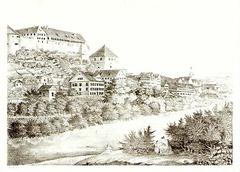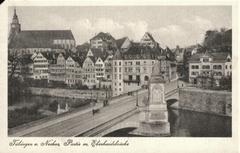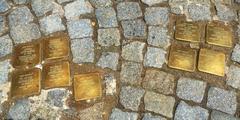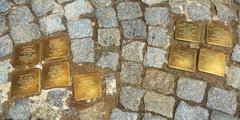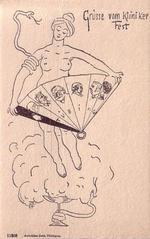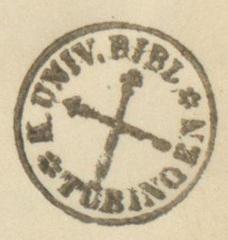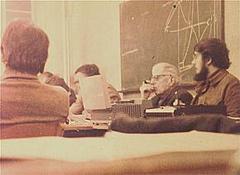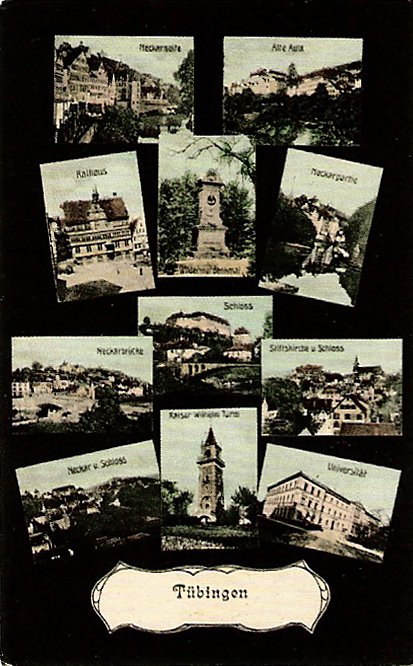
Ottilie Wildermuth Memorial Tübingen — Visiting Hours, Tickets, and Visitor Guide
Date: 14/06/2025
Introduction
The Ottilie Wildermuth Memorial in Tübingen, Germany, stands as a tribute to one of the 19th century’s most influential female authors. Located on the picturesque Neckarinsel, this monument commemorates Ottilie Wildermuth (1817–1877), whose literary works captured the spirit of Swabian culture and advanced the visibility of women in German intellectual life. The memorial, initiated by local women in 1887, is one of Germany’s earliest public monuments dedicated to a female figure, symbolizing both respect for Wildermuth’s achievements and a broader shift in gender representation within public spaces.
This guide offers detailed insights into the memorial’s history, cultural significance, and practical visitor information, including visiting hours, accessibility, travel tips, and nearby attractions. Explore the enduring impact of Ottilie Wildermuth’s work and the evolving role of women in cultural memory. For further exploration, consult Tübingen Tourist Information and consider virtual tours or literary walking routes that feature this landmark. (Wikipedia; Frauen und Geschichte; Tüpedia)
Table of Contents
- The Legacy of Ottilie Wildermuth
- The Memorial: History, Symbolism, and Artistic Features
- Practical Visitor Information
- Visitor Tips & FAQs
- Plan Your Visit
- References
The Legacy of Ottilie Wildermuth
Life and Literary Achievements
Ottilie Wildermuth (née Rooschüz) was born in 1817 in Rottenburg am Neckar. From childhood, she displayed a remarkable intellect and passion for storytelling, enjoying an education in Stuttgart—a rare opportunity for women at the time (Wikipedia). In 1843, she married Wilhelm David Wildermuth and became a central figure in Tübingen’s intellectual society, leading a women’s salon for over three decades.
Her literary debut came in 1847 with the story “Die alte Jungfer,” followed by a prolific output of short stories, novels, biographies, and children’s books. Through periodicals like “Daheim” and “Die Gartenlaube,” her idyllic depictions of Swabian life and nuanced engagement with social themes found a broad audience (Wikipedia; Academia.edu). In 1870, she established the children’s magazine “Jugendgarten,” later continued by her daughters. Her legacy as a role model for educated women was solidified by her receipt of Württemberg’s Great Gold Medal for Art and Science in 1871.
Social Impact and Representation
Wildermuth’s work, particularly “Schwäbische Pfarrhäuser,” played a key role in shaping the image of the “schwäbische Hausfrau”—the diligent, self-sacrificing Swabian housewife (Deutschlandfunk). By founding women’s intellectual circles and children’s publications, she paved the way for increased female participation in public and literary spheres.
The Memorial: History, Symbolism, and Artistic Features
Conception and Unveiling
The memorial was unveiled in 1887 on Tübingen’s Neckarinsel, spearheaded by local women’s groups—a progressive initiative in an era when nearly all public monuments celebrated male figures (Frauen und Geschichte). The unveiling was a notable civic event, attended by citizens and marked by speeches and poetry honoring Wildermuth’s achievements (Wikisource).
Design and Artistic Features
The monument features a sandstone base with a bronze high-relief bust of Ottilie Wildermuth, crafted by sculptor Wilhelm Rösch. The dedication—“Ottilie Wildermuth gewidmet von deutschen Frauen” (“Dedicated to Ottilie Wildermuth by German women”)—underscores the collective spirit behind its creation. Its placement on the Neckarinsel, a beloved public park, ensures accessibility and continuous public engagement (Komoot; Wikipedia).
Practical Visitor Information
Opening Hours & Accessibility
- Open-Air Monument: Accessible year-round, 24 hours a day; there are no gates or restricted hours.
- Entry Fee: Free of charge; no ticket required.
- Accessibility: Paved, level paths lead to the memorial, suitable for wheelchairs and strollers, though some surfaces may be uneven due to tree roots (LFRBW).
- Benches: Available nearby for rest and contemplation.
How to Get There
- Location: Neckarinsel, near the Alleenbrücke and Platanenallee in Tübingen (Mapcarta).
- By Foot: 10–15 minutes from Tübingen’s old town; follow signs to Neckarinsel.
- Public Transport: Tübingen Hauptbahnhof is about 1 km away; walk or take local buses to the old town and proceed on foot (Germany Footsteps).
- By Car: Park at Parkhaus Altstadt-Mitte or Parkhaus Neckar; Neckarinsel itself is pedestrian-only.
Best Times to Visit & Guided Tours
- Best Seasons: Spring through autumn for the most pleasant weather and lush scenery.
- Guided Tours: No permanent tours focus exclusively on the memorial, but city walking tours on literary or women’s history themes may include it. Check with Tübingen Tourist Information for current offerings.
Nearby Attractions
- Hölderlinturm: Residence of poet Friedrich Hölderlin, just across the river.
- Alte Botanischer Garten: The old botanical garden is a short walk away.
- Tübingen Altstadt: Explore half-timbered houses, shops, and cafés near the Neckar.
- Wildermuth-Gymnasium & Wilhelmstraße 14: Sites associated with Wildermuth’s life (Tüpedia).
Visitor Tips & FAQs
Essential Tips
- Dress for Weather: The memorial is outdoors; bring appropriate clothing and sun protection.
- Photography: The site is especially photogenic in early morning or late afternoon.
- Reading: Enhance your visit by exploring Wildermuth’s works or visiting the University Library Tübingen.
- Facilities: Restrooms and cafés are available in the nearby old town; none directly at the memorial.
Frequently Asked Questions
Is there an entry fee?
No, the memorial is free and open year-round.
What are the opening hours?
As part of the public park, it is accessible at all times; daylight hours are recommended.
Is the memorial wheelchair accessible?
Yes, the main paths are suitable, though some areas may be uneven.
Are guided tours available?
No dedicated tours, but some city literary or women’s history tours may include the memorial.
Can I combine my visit with other sites?
Yes, the memorial is close to the Hölderlinturm, old botanical garden, university, and old town.
Plan Your Visit
The Ottilie Wildermuth Memorial is a serene and culturally significant destination in Tübingen, offering both historical context and peaceful natural surroundings. Its free, open access and proximity to other major sites make it an ideal stop for anyone exploring this charming university city.
For further information, guided tours, and event updates, use the Tübingen Tourist Information and download the Audiala app to enhance your visit. Don’t forget to explore Wildermuth’s legacy in local bookstores and libraries, and enjoy the unique blend of literary history and scenic beauty that Tübingen offers.
References and Further Reading
- Ottilie Wildermuth – Wikipedia
- Frauen und Geschichte
- Tüpedia: Ottilie Wildermuth
- Deutschlandfunk: Von der schwäbischen Hausfrau
- WKGO Blog – Ottilie Wildermuth
- Komoot: Ottilie Wildermuth Memorial
- University Library Tübingen: Ottilie Wildermuth Collection
- LFRBW: Frauenorte – Ottilie Wildermuth
- Germany Footsteps: Things to Do in Tübingen
- Mapcarta: Ottilie Wildermuth Memorial
